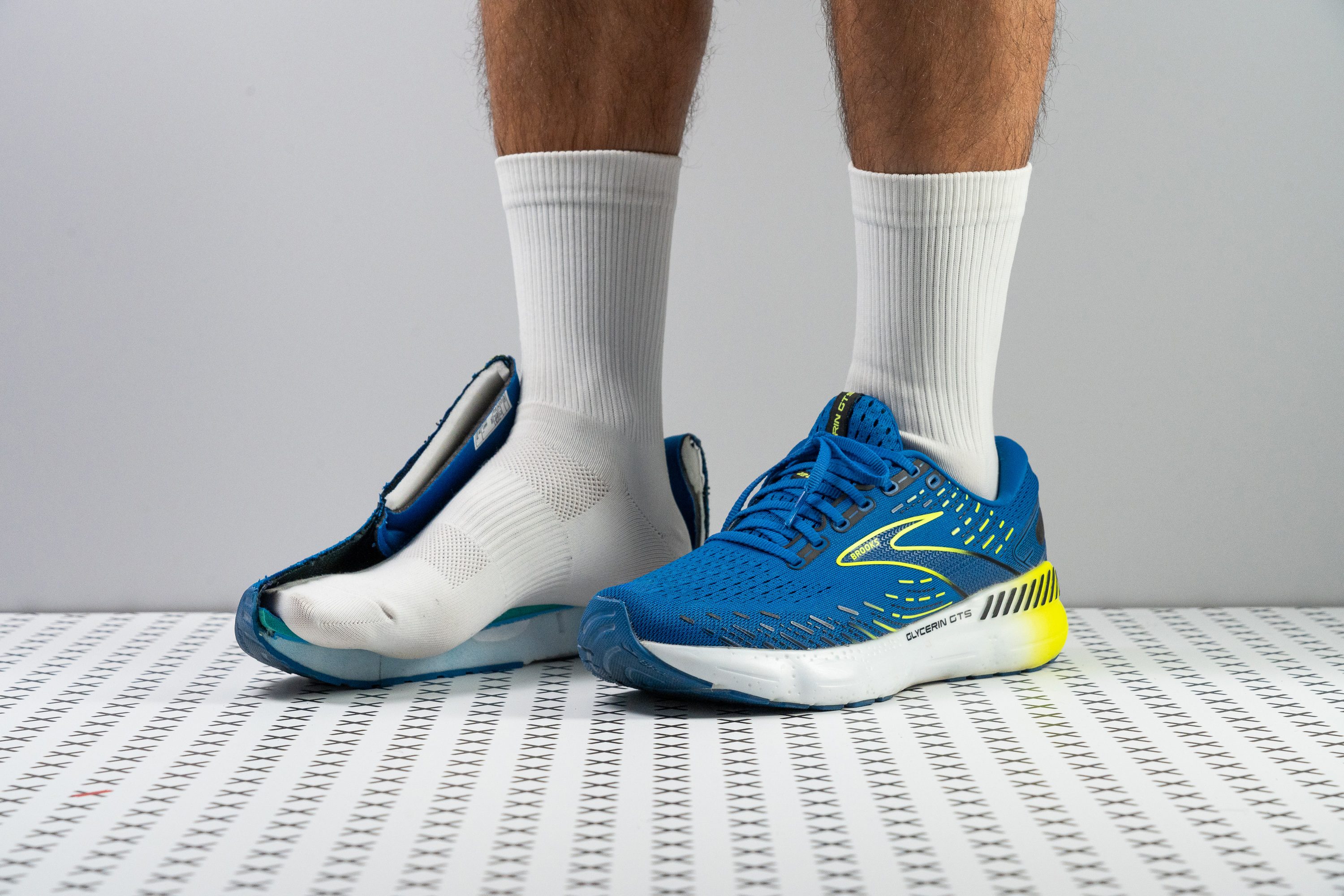Our verdict
Pros
- Excellent for heel strikers
- Provides protective cushioning
- Offers comfort on easy running days
- Ensures smooth transitions
- Features a secure heel counter
- Comes with a soft, stretchy upper
- Good breathability
- Effective GuideRails system
Cons
- Midsole may feel overly firm for some runners
- Pricier than many alternatives
- On the heavier side
Audience verdict
- Top 15% in road running shoes
- Top 11% in Brooks running shoes
Comparison
The most similar running shoes compared
+ + Add a shoe | |||||
|---|---|---|---|---|---|
| Audience score | 90 Superb! | 88 Great! | 79 Good! | 85 Good! | |
| Price | $160 | $170 | $165 | $140 | |
| Pace | Daily running | Daily running | Daily running | Daily running | |
| Shock absorption | - | - | Moderate | - | |
| Energy return | - | - | Low | - | |
| Traction | - | - | Moderate | - | |
| Arch support | Stability | Stability | Stability | Stability | |
| Weight lab Weight brand | 10.9 oz / 309g 10.5 oz / 298g | 11.6 oz / 329g 11.8 oz / 334g | 10.8 oz / 305g 10.7 oz / 303g | 12.5 oz / 353g 12.2 oz / 346g | |
| Drop lab Drop brand | 11.0 mm 10.0 mm | 7.2 mm 8.0 mm | 10.1 mm 10.0 mm | 12.1 mm 12.0 mm | |
| Strike pattern | Heel | HeelMid/forefoot | Heel | Heel | |
| Size | True to size | Slightly small | True to size | Slightly small | |
| Midsole softness | Balanced | Balanced | Balanced | Firm | |
| Difference in midsole softness in cold | Small | Normal | Normal | Small | |
| Toebox durability | Bad | Decent | Decent | Decent | |
| Heel padding durability | Bad | Bad | Good | Good | |
| Outsole durability | Good | Good | Good | Good | |
| Breathability | Moderate | Moderate | Breathable | Moderate | |
| Width / fit | Narrow | Medium | Medium | Medium | |
| Toebox width | Medium | Wide | Medium | Medium | |
| Stiffness | Stiff | Stiff | Moderate | Stiff | |
| Torsional rigidity | Stiff | Stiff | Stiff | Stiff | |
| Heel counter stiffness | Stiff | Stiff | Moderate | Moderate | |
| Heel lab Heel brand | 36.5 mm 38.0 mm | 39.1 mm 41.0 mm | 37.8 mm 39.0 mm | 36.5 mm 36.0 mm | |
| Forefoot lab Forefoot brand | 25.5 mm 28.0 mm | 31.9 mm 33.0 mm | 27.7 mm 29.0 mm | 24.4 mm 24.0 mm | |
| Widths available | NormalWide | NormalWide | NormalWideX-Wide | NarrowNormalWideX-Wide | |
| Orthotic friendly | ✓ | ✓ | ✓ | ✓ | |
| Season | All seasons | All seasons | SummerAll seasons | All seasons | |
| Removable insole | ✓ | ✓ | ✓ | ✓ | |
| Ranking | #82 Top 13% | #134 Top 37% | #319 Bottom 13% | #221 Bottom 40% | |
| Popularity | #295 Top 45% | #295 Bottom 20% | #44 Top 12% | #161 Top 44% |
Who should buy
In our view, the Brooks Glycerin GTS 20 stands out as an excellent stability shoe, tailored to meet the needs of:
- Runners looking for a versatile shoe with massive support in both the heel and midfoot areas.
- Brooks enthusiasts aiming to add a daily stability trainer to their collection.
- Heel strikers who want a well-cushioned stability running shoe and don't mind the $160 price tag.

Who should NOT buy
If you're on the hunt for a lightweight yet stable running shoe, the Glycerin GTS 20 might not be your best bet based on our lab tests. Consider a lighter and more affordable option like the Saucony Tempus.
In our view, this shoe might also not be the best choice for midfoot or forefoot strikers due to its significant heel-to-toe drop. For runners who strike with this part of their foot, a flatter shoe with stability features, such as the Hoka Gaviota 4, is a more reasonable choice.
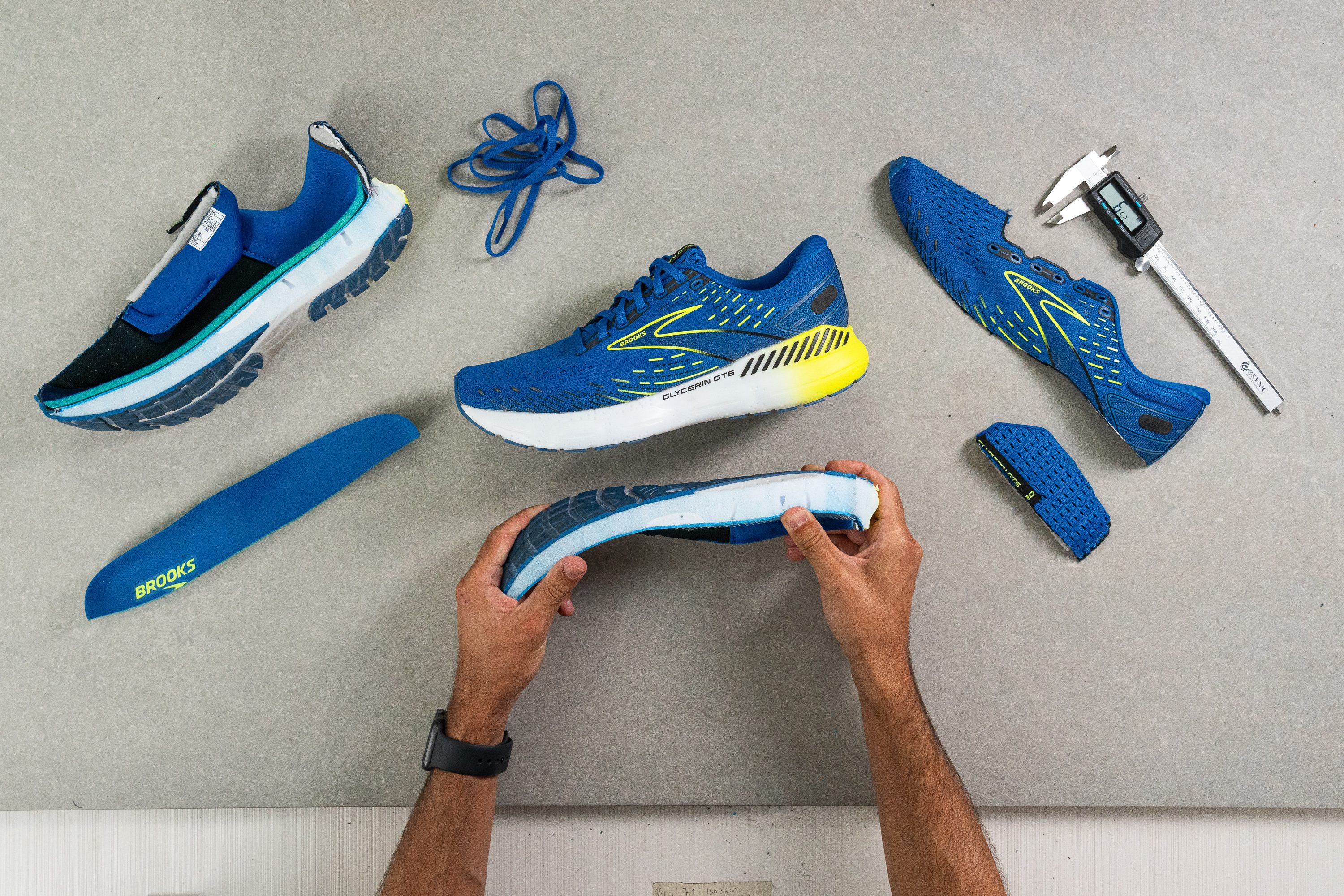
Cushioning
Heel stack
Brooks took a conservative approach here, providing a generous amount of foam in the heel. They are aware that most overpronators are heel strikers who need extra cushioning in this area.
With 36.5 mm of nitrogen-infused DNA LOFT v3, there's no possibility of feeling the ground through this shoe.

| Glycerin GTS 20 | 36.5 mm |
| Average | 34.8 mm |
Forefoot stack
This explains why the forefoot cushioning is fairly typical, measuring at 25.5 mm. Not many forefoot strikers are likely to single out this shoe as their top choice.
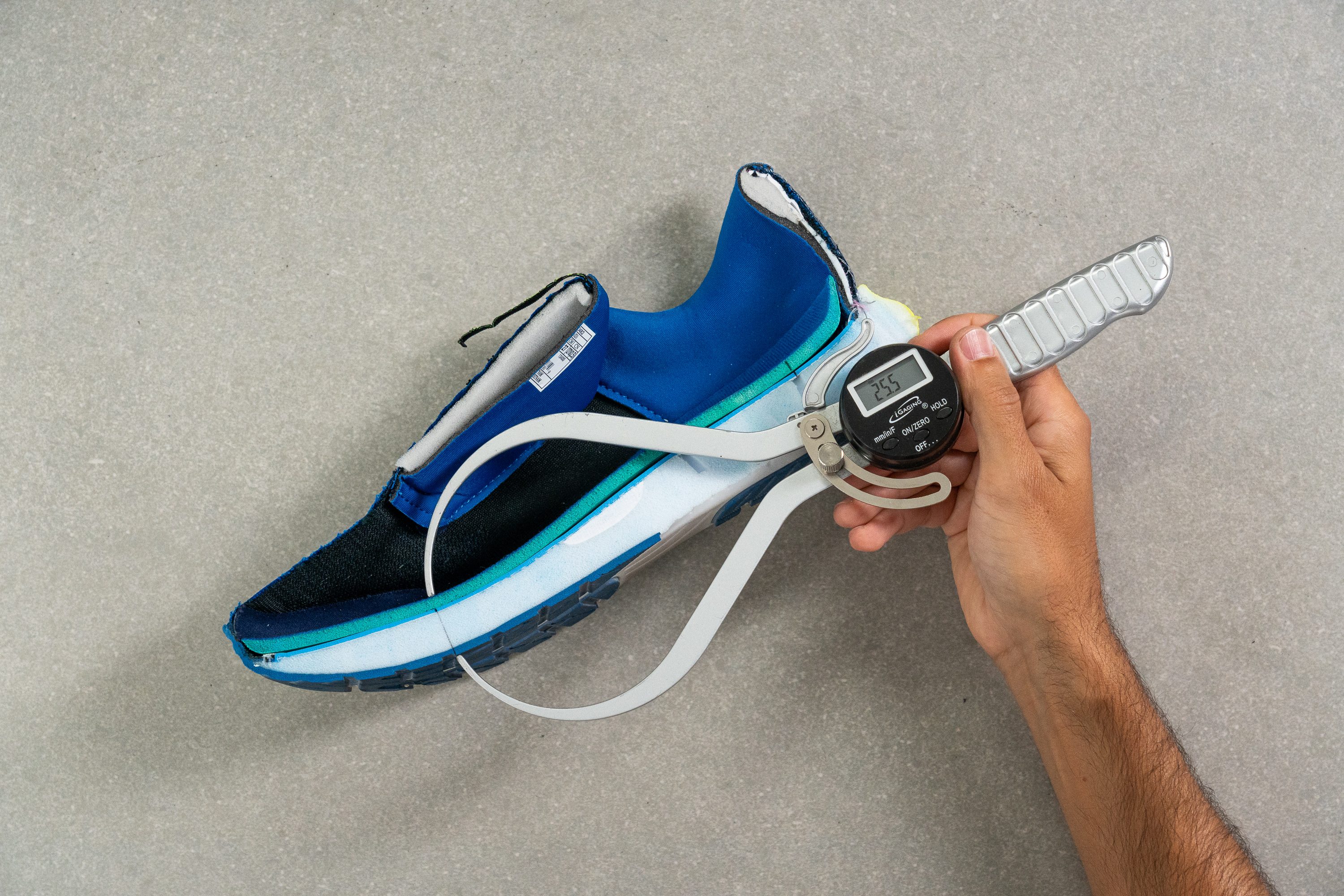
| Glycerin GTS 20 | 25.5 mm |
| Average | 26.2 mm |
Drop
This results in an 11-mm heel-to-toe drop, which is 1 mm away from the official numbers provided by Brooks (10 mm).
This slight discrepancy is perfectly acceptable.
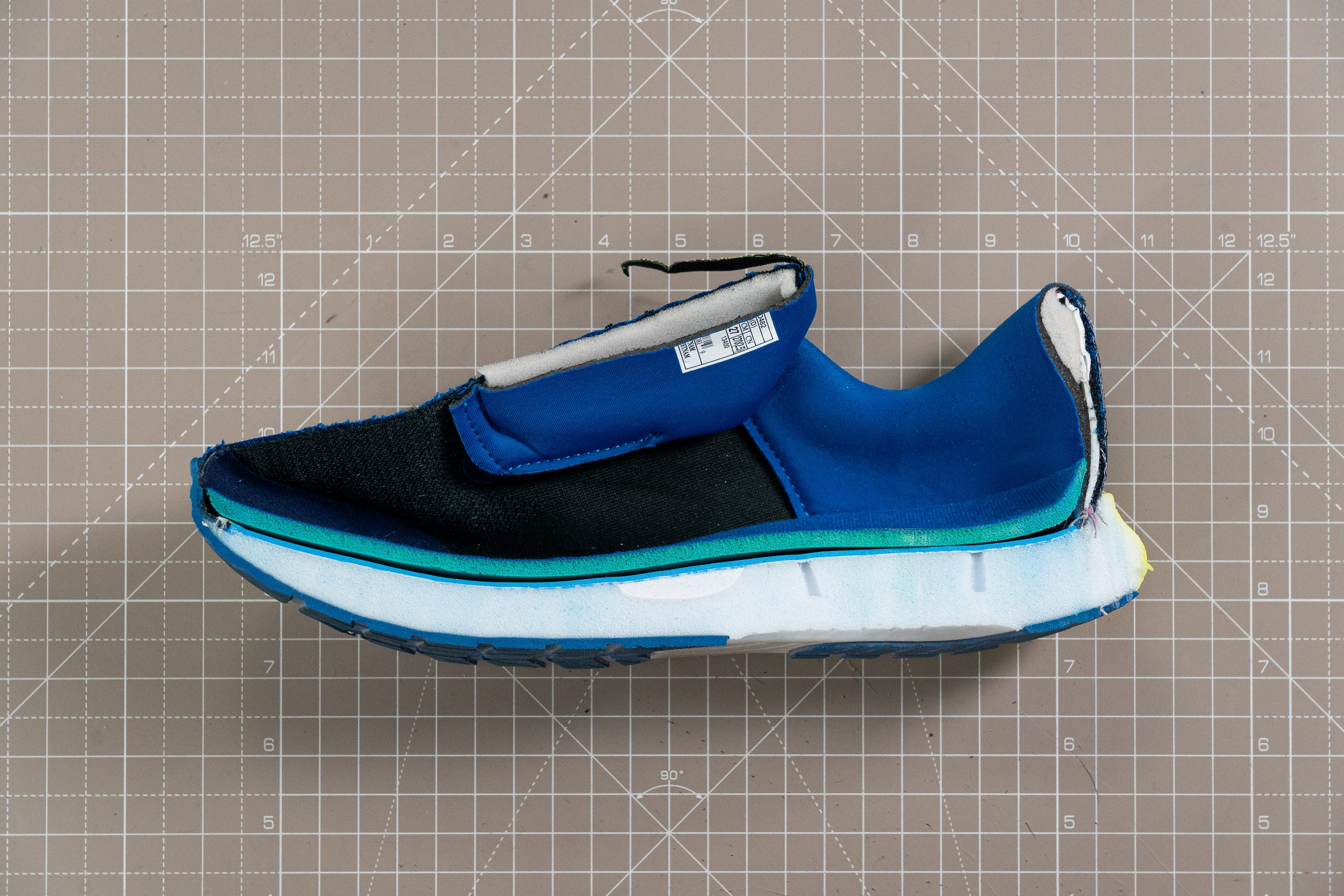
| Glycerin GTS 20 | 11.0 mm |
| Average | 8.6 mm |
Midsole softness
DNA LOFT v3 is a nitrogen-infused midsole, making it lighter and more responsive than the standard DNA LOFT.
But don't anticipate a super-plush experience like in a Nike Invincible 3. With a softness measurement of 23.4 HA, this foam delivers a balanced, comfortable feel that's well-suited for stability-focused shoes like this one.
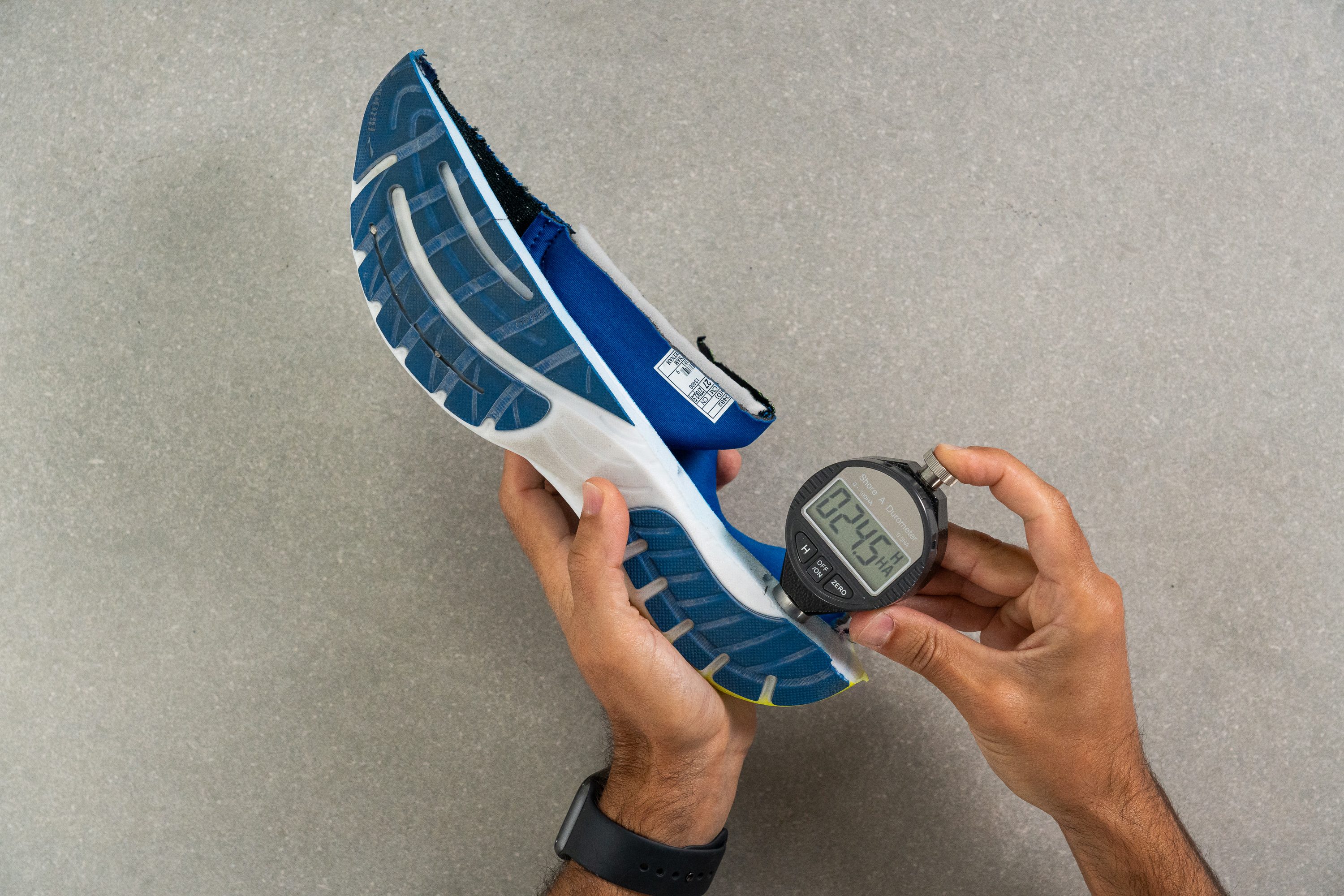
| Glycerin GTS 20 | 23.4 HA |
| Average | 20.4 HA |
Size and fit
Size
Brooks Glycerin GTS 20 fits true to size (199 votes).
Width / Fit
When we shifted our attention to the toe box, we didn't find the shoe particularly spacious or restrictive—it just felt average to us.
This impression was confirmed by our measurements, which showed a maximum width of 97.9 mm, firmly in the average range.
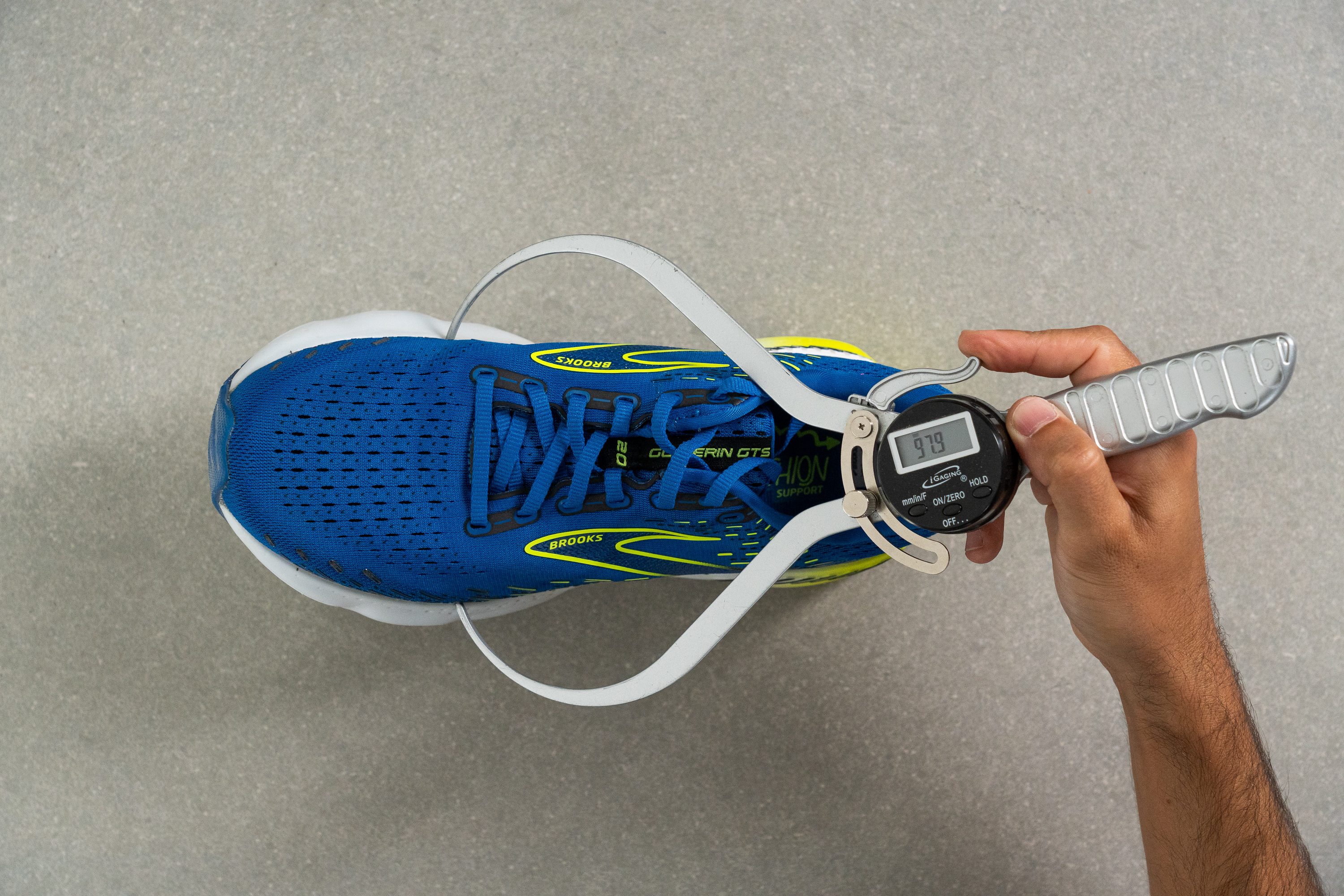
This test follows an older methodology, which is why you don't see recently tested shoes in the chart. Results from different methodologies can not be compared.
| Glycerin GTS 20 | 97.9 mm |
| Average | 98.5 mm |
Toebox width
Nonetheless, we found our toes enjoying a touch more wiggle-room than expected. This extra space was substantiated by a 78.9 mm measurement.

This test follows an older methodology, which is why you don't see recently tested shoes in the chart. Results from different methodologies can not be compared.
| Glycerin GTS 20 | 78.9 mm |
| Average | 78.4 mm |
Flexibility / Stiffness
High torsional rigidity is almost a given for any stability shoe, but this isn't necessarily the case when it comes to stiffness. Indeed, it wouldn't make sense for a shoe designed for daily runs to be super stiff.
In alignment with this, our measurement for the 90-degree bend test came in at only 24.9N, which falls below the average result. This explains why the shoe provides such a comfortable ride during easy aerobic runs.
This test follows an older methodology, which is why you don't see recently tested shoes in the chart. Results from different methodologies can not be compared.
| Glycerin GTS 20 | 24.9N |
| Average | 28.1N |
Stiffness in cold (%)
After placing the shoe in the freezer for 20 minutes and repeating the test, we found that it became stiffer. However, this change was consistent with the results we've seen from other shoes tested under the same conditions.
The increase we measured in the lab is a substantial 41.2%, a change that you can clearly feel underfoot. Yet this is a typical outcome that we anticipate from a shoe with an EVA-based foam.
| Glycerin GTS 20 | 41% |
| Average | 33% |
Weight
A significant disappointment with this shoe is its excessive weight. The scale reveals a 10.9 oz (309g) reality for a US size 9—just too much by contemporary standards.
We are eagerly looking to the next release, hoping that Brooks will take the necessary steps to bring this shoe's weight under the 10 oz benchmark.
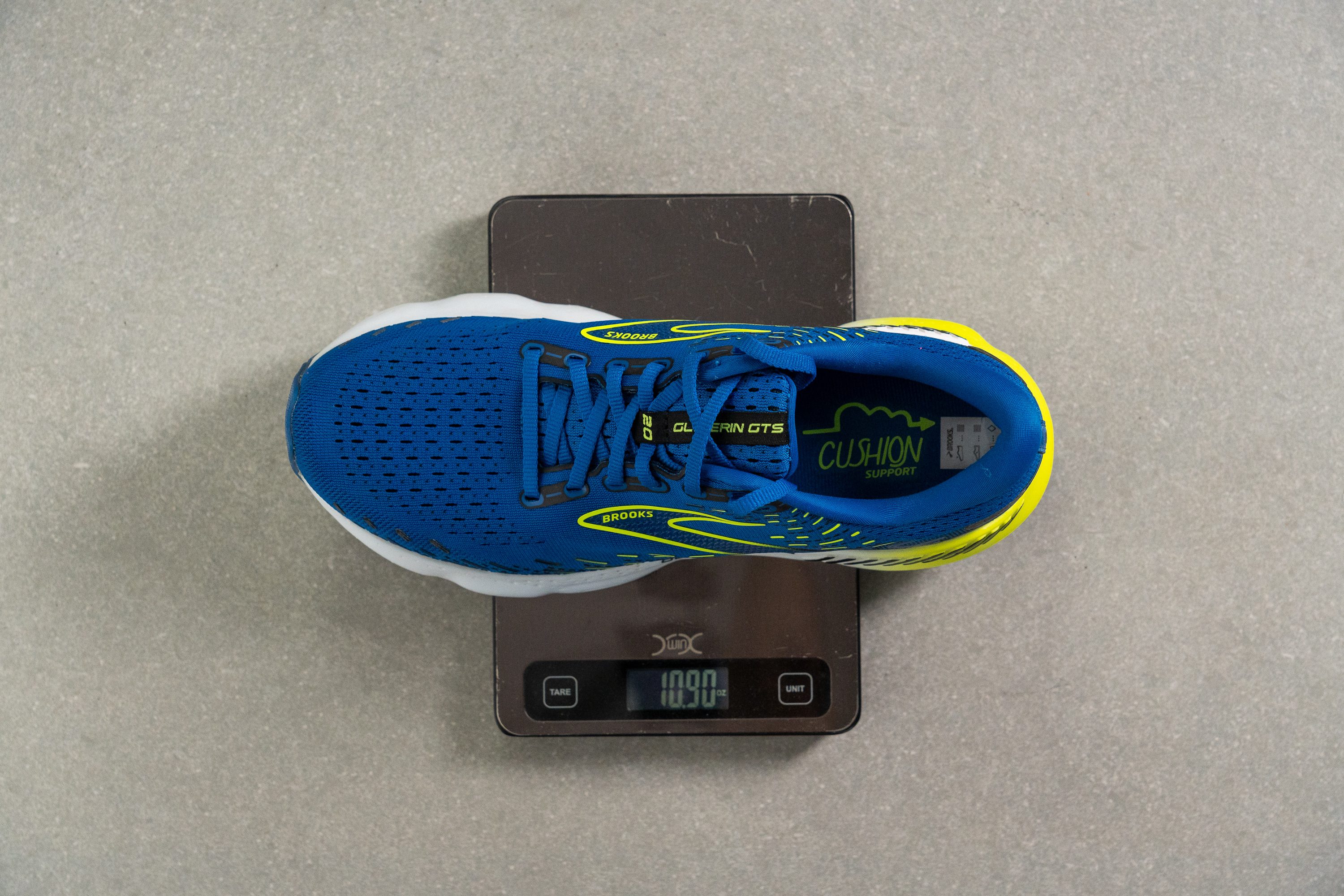
| Glycerin GTS 20 | 10.9 oz (309g) |
| Average | 9.3 oz (264g) |
Breathability
Even though the engineered mesh upper that Brooks incorporates doesn't offer the ultimate ventilation, we gave it a respectable 4/5 in our breathability test.
The results show that even in warmer climates, the shoe maintains its cool. Yet an added advantage of not being overly breathable is that it can keep your feet warm during winter when paired with thick socks.
Upon testing with light, it's clear that Brooks prioritized ventilation in the toe box. This strategy is one of the most effective for maintaining good airflow and ensuring adequate ventilation.
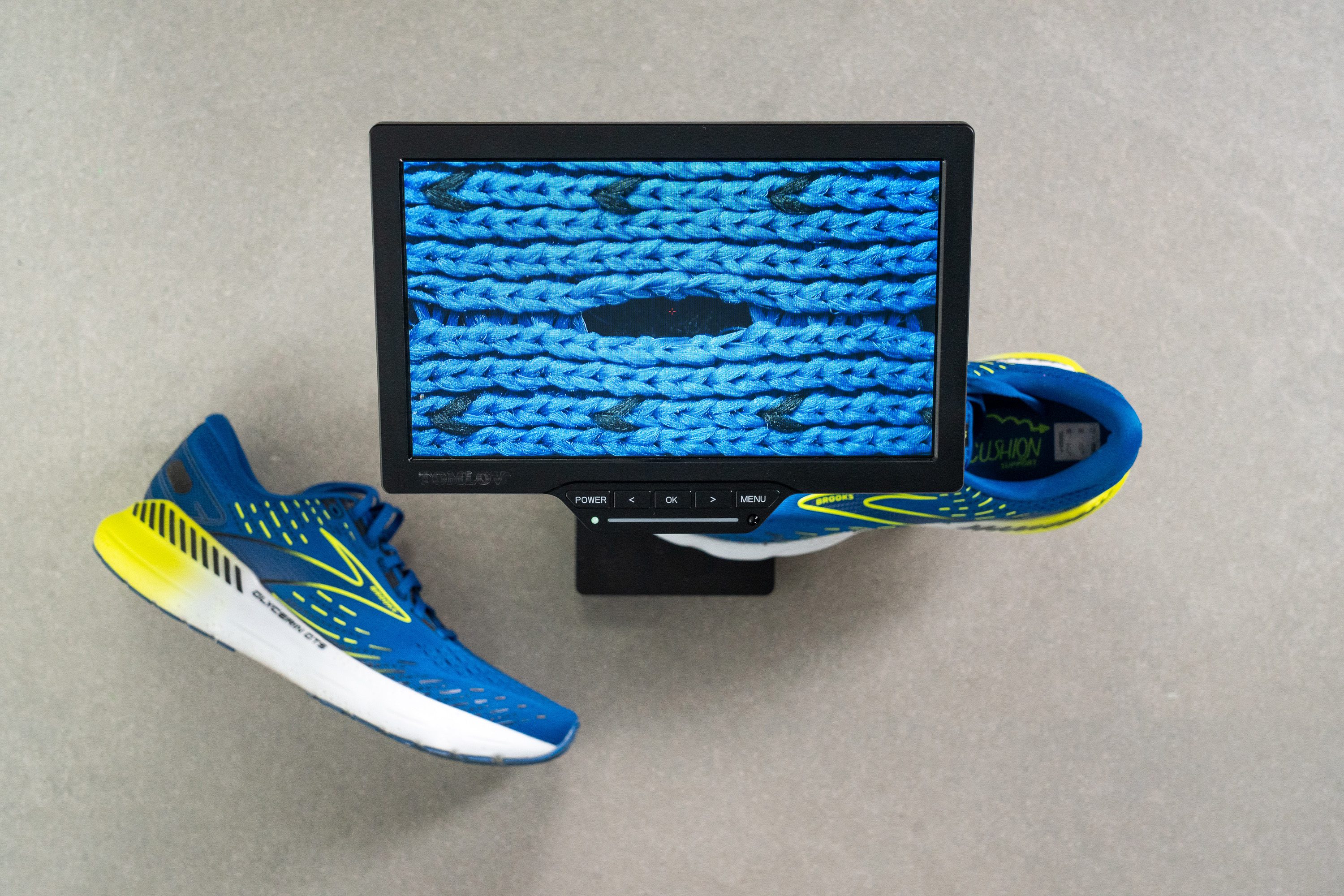
This focus on ventilation becomes even more apparent under a microscope, right? We strive to examine the ventilation holes as closely as possible, and we seem to have succeeded in that.
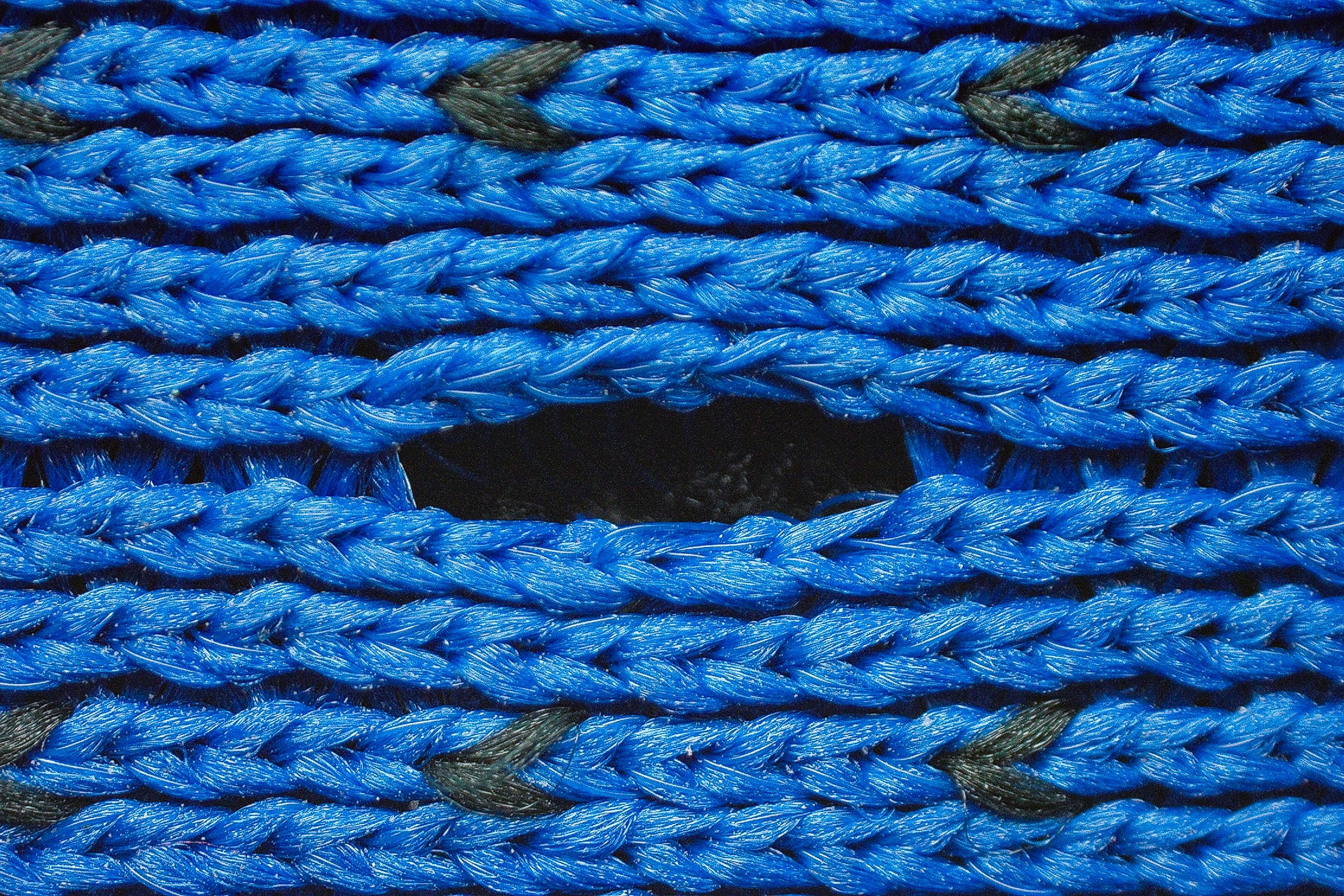
| Glycerin GTS 20 | 4 |
| Average | 3.7 |
Stability
Lateral stability test
Living up to its reputation, the Brooks Glycerin GTS 20 indeed proves itself as a stability shoe, and we're absolutely delighted to confirm that it truly delivers in this aspect!
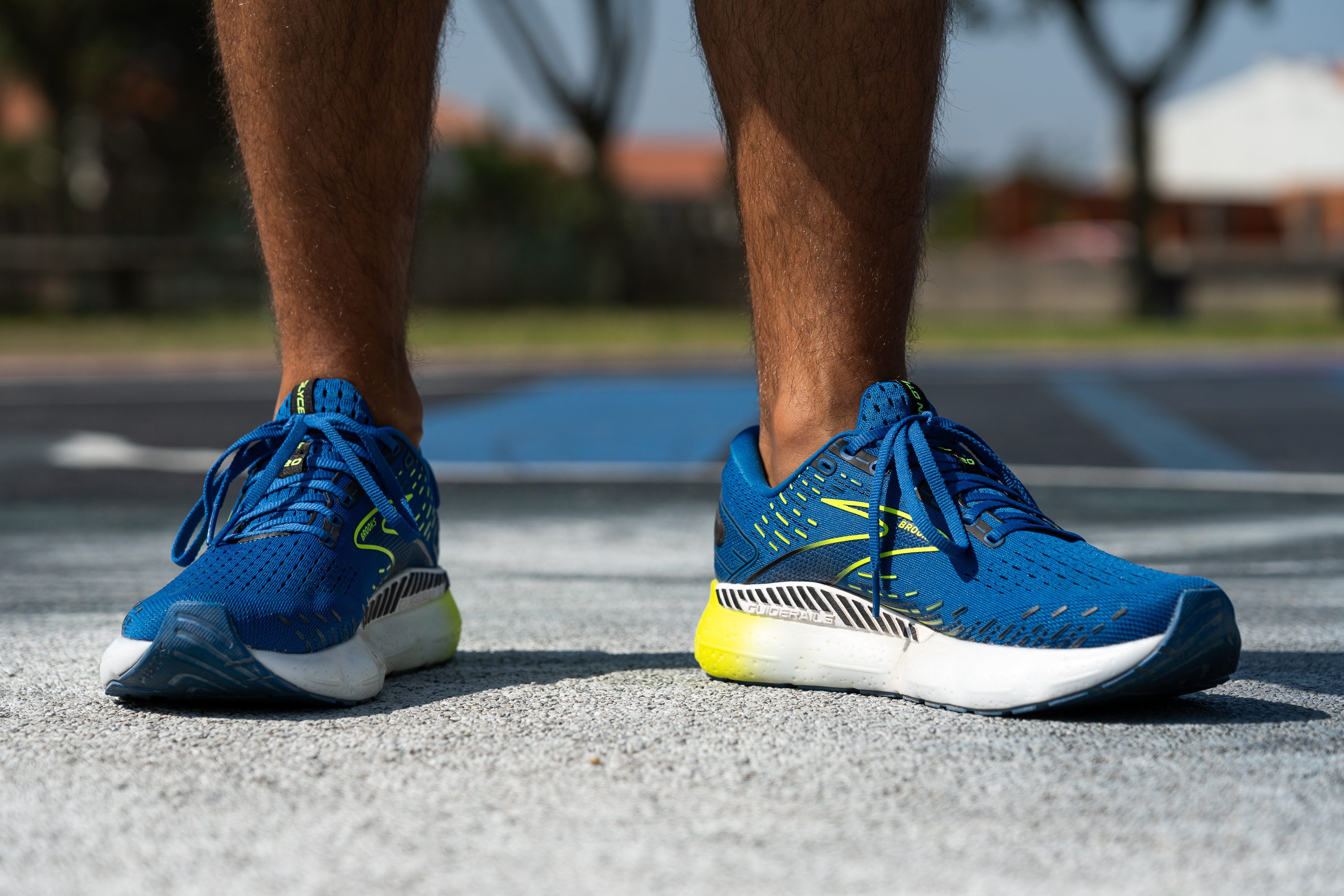
The renowned GuideRails system that Brooks deploys across a range of stability shoes is nothing short of miraculous for overpronators.
Torsional rigidity
Stability in any shoe necessitates at least a moderate level of torsional rigidity, and the GTS 20 confidently embodies this trait. Our assessment scores it a solid 4 out of 5, a rating that unquestionably surpasses the average result.
| Glycerin GTS 20 | 4 |
| Average | 3.5 |
Heel counter stiffness
The rigidity of the heel counter plays an essential role too. Despite the potential discomfort some might feel with a firm heel counter, it becomes almost indispensable in stability-focused shoes. It helps prevent the shoe from lateral collapse, especially crucial for heel strikers.
In the GTS 20, we've discovered a built-like-a-tank 5/5 heel counter. While we might have preferred a bit more flexibility, we comprehend and support Brooks' whole-hearted commitment to this design, being their ultimate goal to ensure top-tier stability for heel strikers.
| Glycerin GTS 20 | 5 |
| Average | 2.9 |
Midsole width - forefoot
An additional stability-boosting tactic often employed by brands involves expanding the shoe's landing base. Quite intuitive, isn't it?
Brooks has opted for an ultra-wide design in this case. With a forefoot width of 119.5 mm, it ranks among the widest shoes we've ever analyzed in our lab!
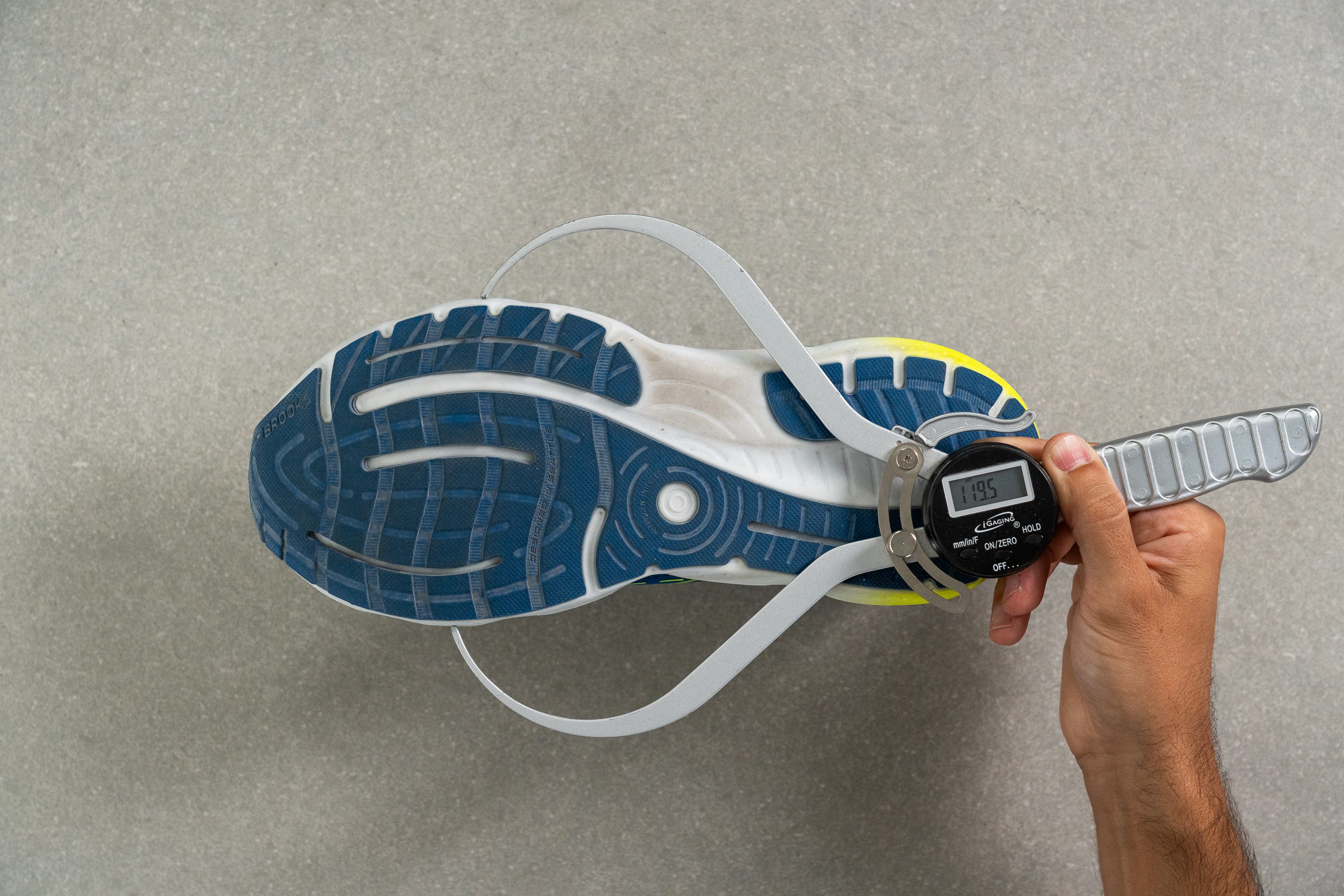
| Glycerin GTS 20 | 119.5 mm |
| Average | 114.4 mm |
Midsole width - heel
This concept extends to the heel as well. With every stride, the widened shoe naturally provides stability. Our measurement for the heel came in at 98.9 mm, surpassing the usual standards.
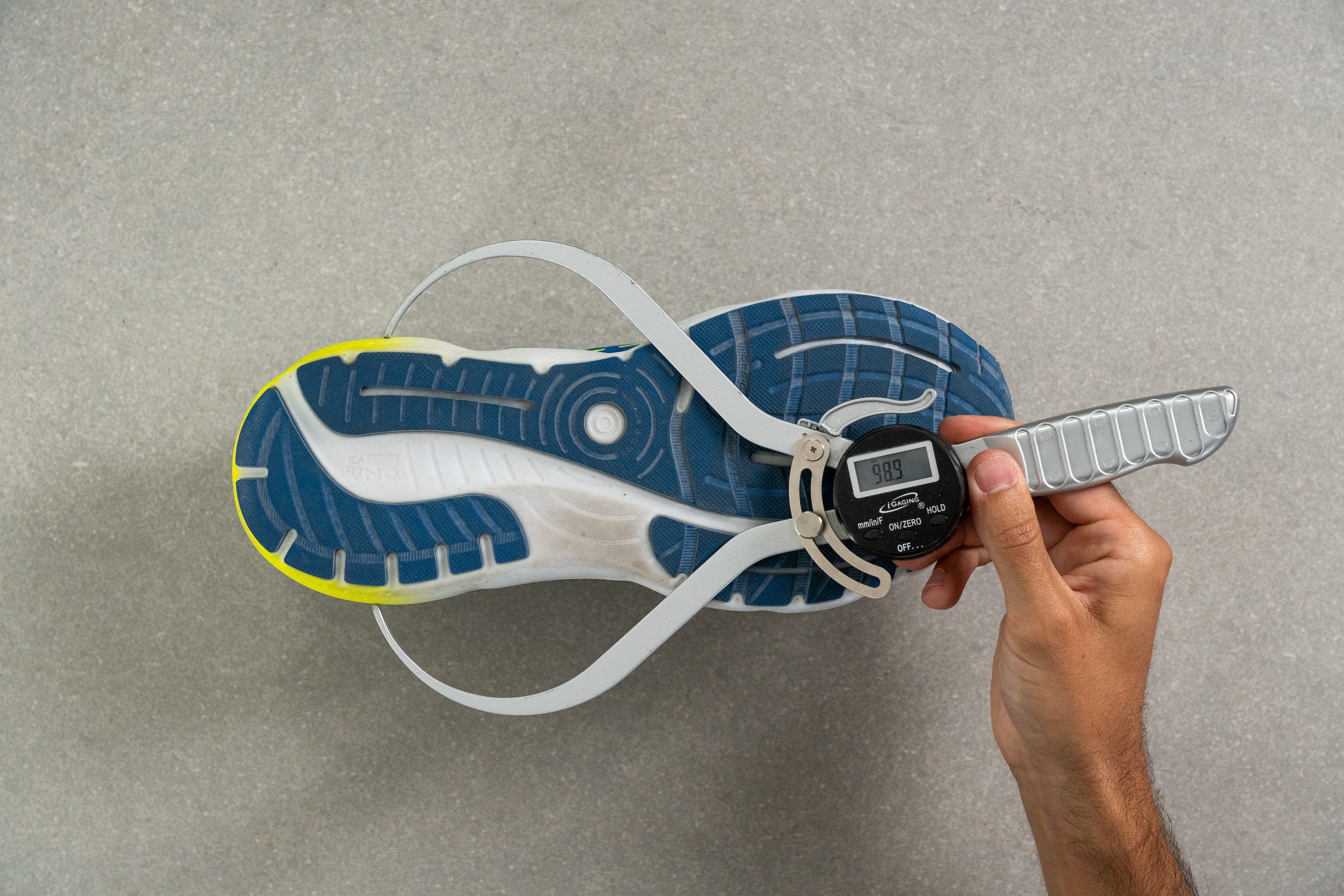
| Glycerin GTS 20 | 98.9 mm |
| Average | 90.7 mm |
Durability
Toebox durability
Our initial impressions of a shoe often come from the feel of it in our hands, before we even start the tests.
For the Glycerin 20 GTS, it was evident early on that the upper might not be sturdy at all. Of course, we always hold out hope that we might be surprised.
Regrettably, our concerns were confirmed once we the Dremel met the upper. The engineered mesh from Brooks couldn't withstand the pressure—it disintegrated instantly.
With such disappointing results, we had no option but to assign the Glycerin 20 GTS a score of 1/5.
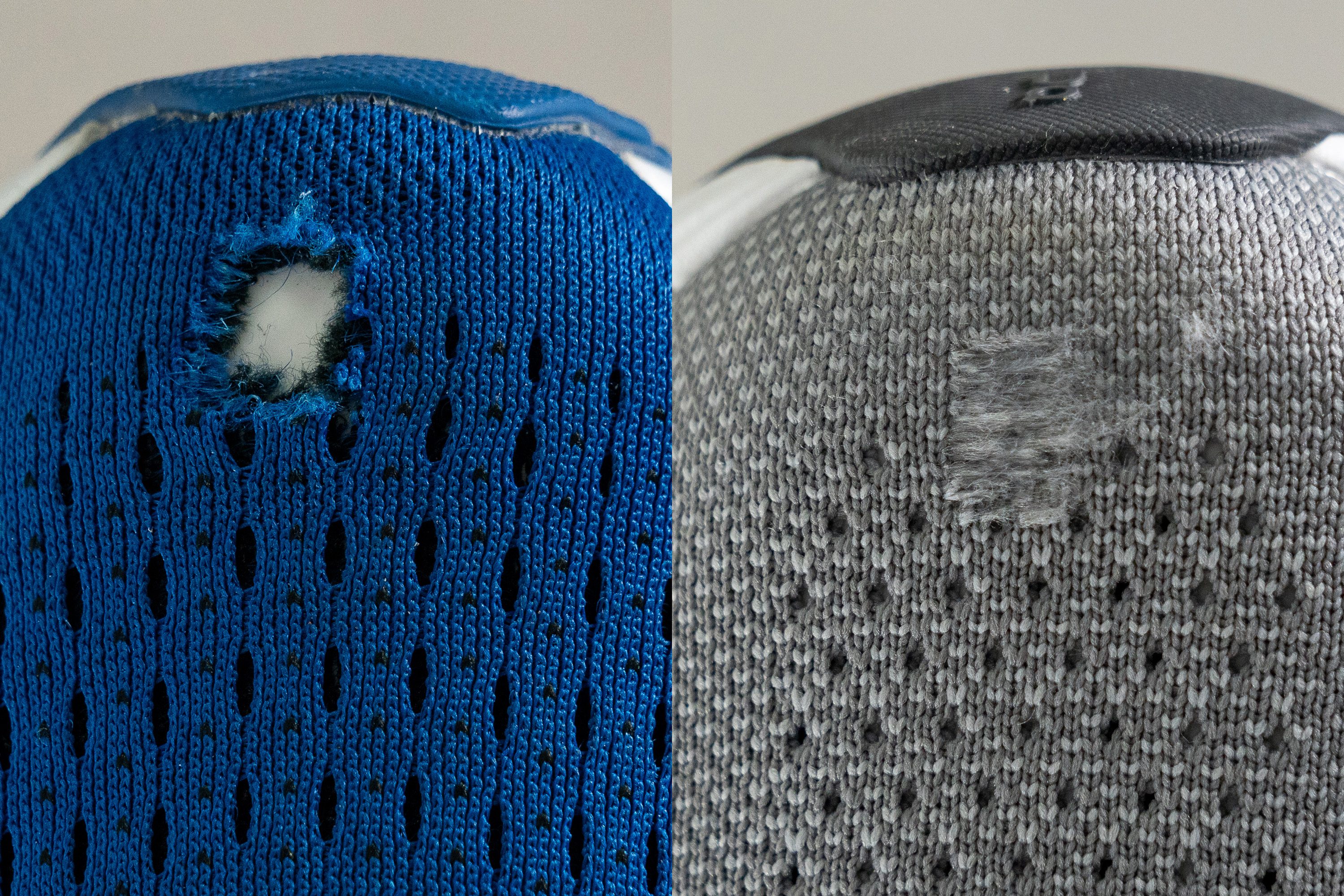
| Glycerin GTS 20 | 1 |
| Average | 2.6 |
Heel padding durability
The trend continues with the heel counter. When we subjected it to the same force using the Dremel, the results were equally disappointing.
Consequently, we awarded it a score of 1/5 as well.

| Glycerin GTS 20 | 1 |
| Average | 3.4 |
Outsole hardness
Daily training shoes typically register hardness values above 75 HC, so we were genuinely surprised when we obtained a measurement of only 69.4 HC.
Softer rubber often leads to premature wear in the outsole, but could this be the case here?
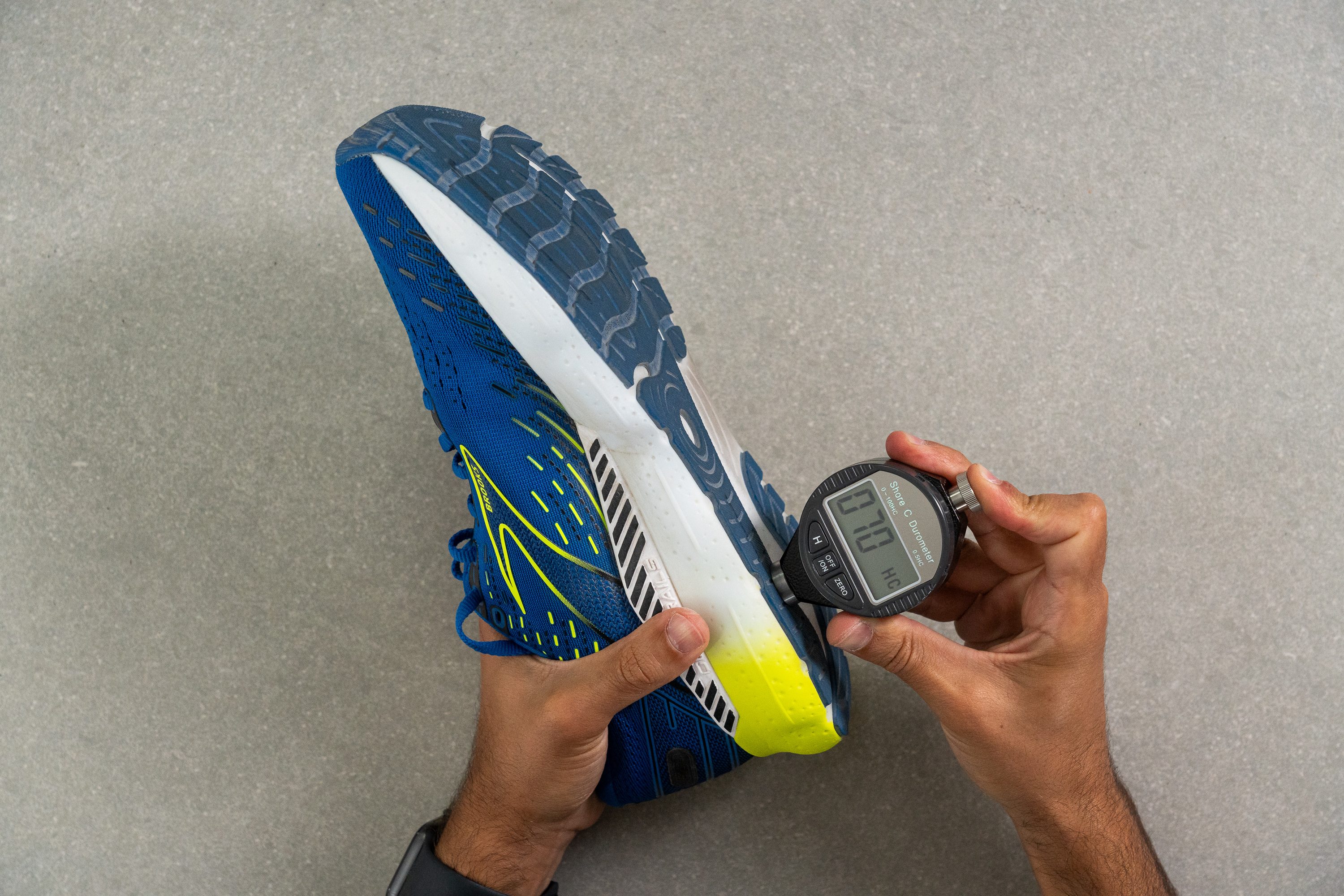
| Glycerin GTS 20 | 69.4 HC |
| Average | 79.2 HC |
Outsole durability
Luckily, that doesn't seem to be the case. We put the Brooks rubber to the test again with the Dremel, and it held up quite well.
We were only able to create a 0.49 mm indentation in the outsole, which, by any measure, is an impressive result.
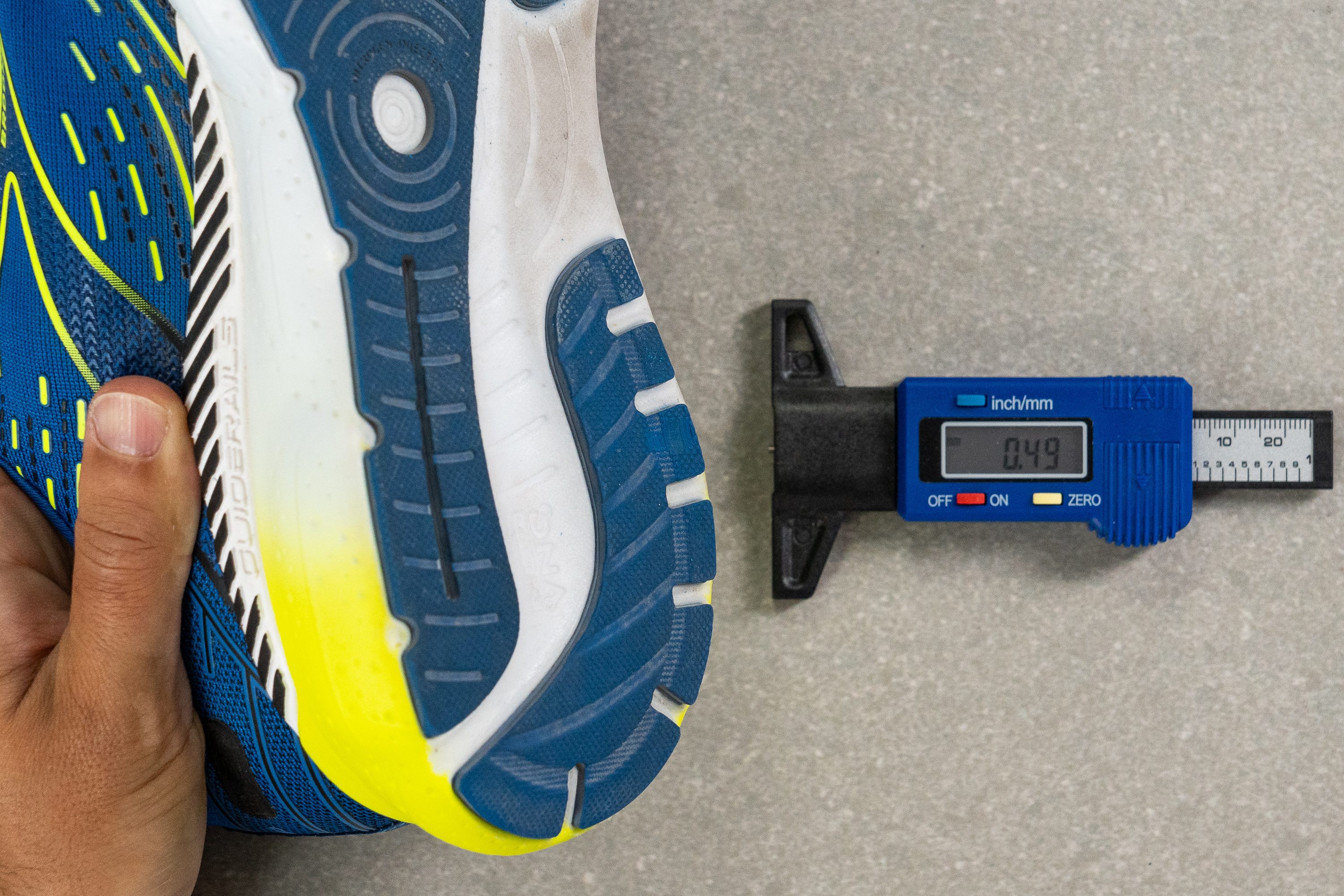
| Glycerin GTS 20 | 0.5 mm |
| Average | 1.1 mm |
Outsole thickness
At a solid 3.3 mm, it appears there's sufficient rubber, which should hold up for as long as the foam maintains its cushioning.
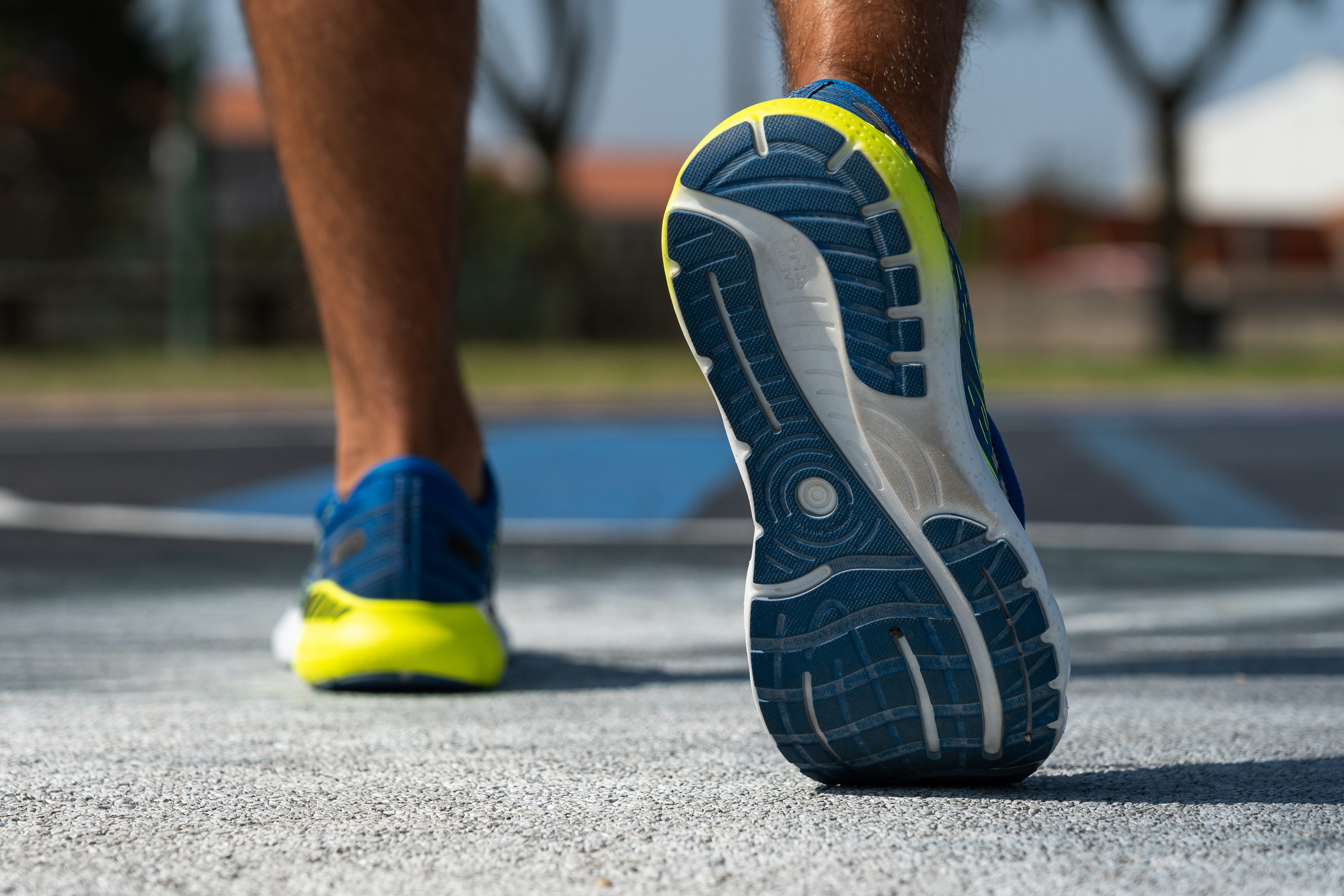
There's some exposed foam in non-important parts, yet nothing to worry about.
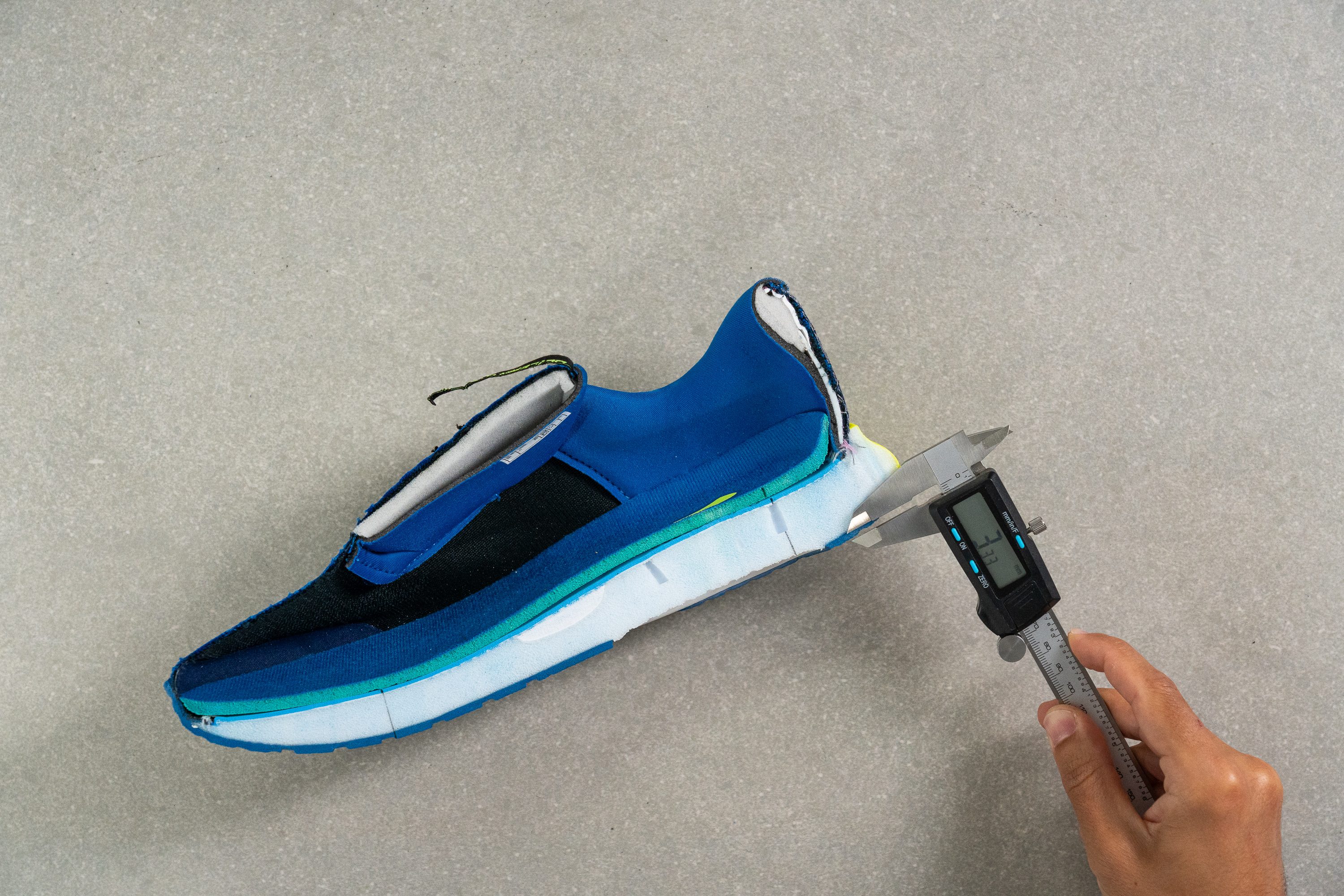
| Glycerin GTS 20 | 3.3 mm |
| Average | 3.2 mm |
Misc
Insole thickness
Brooks understands that the Glycerin line needs to epitomize comfort, and that means including a plush, thick insole.
Ours measurement came at 5 mm, which seems solid to us.
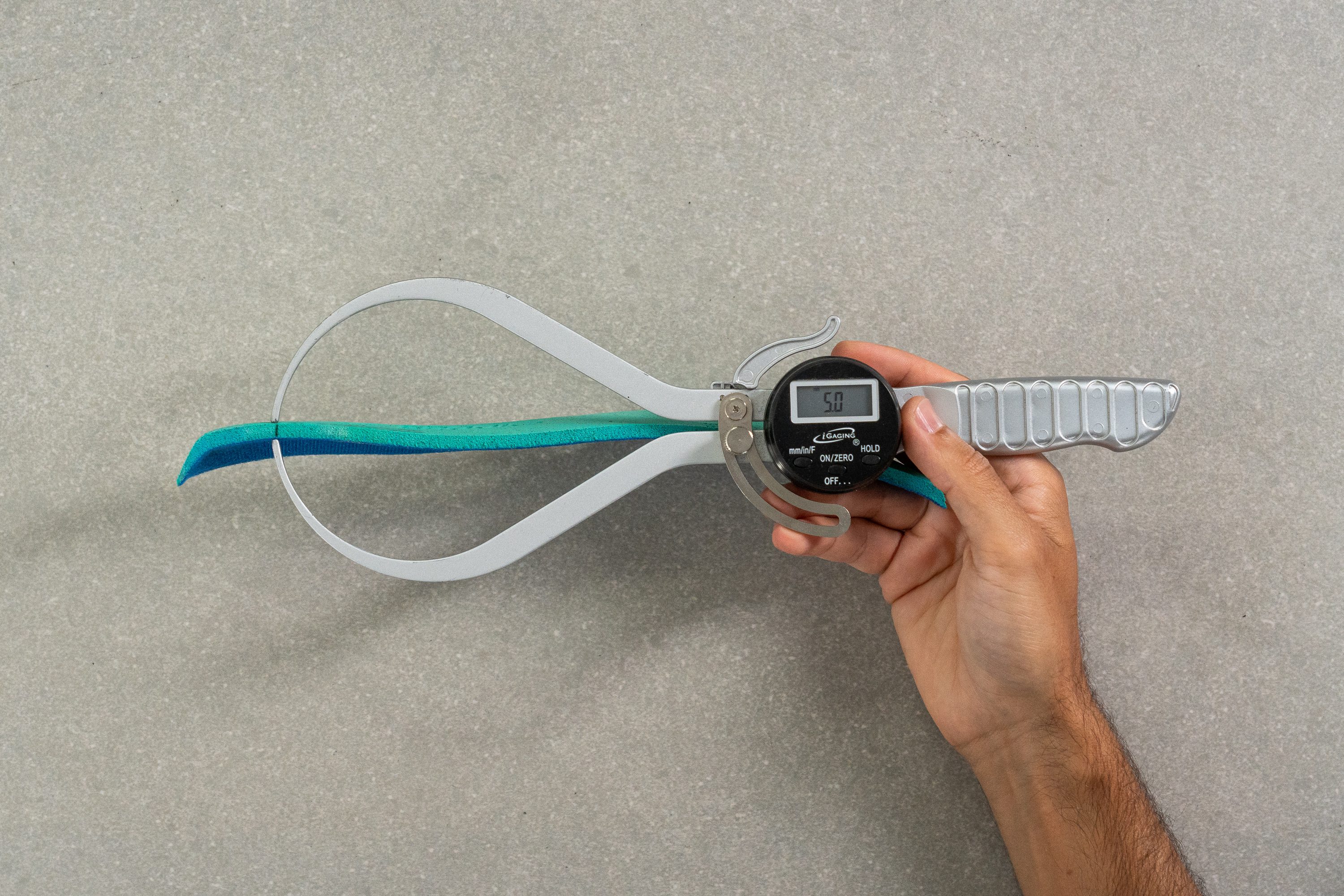
| Glycerin GTS 20 | 5.0 mm |
| Average | 4.5 mm |
Removable insole
The GTS 20 welcomes the use of custom orthotics or third-party insoles.

| Glycerin GTS 20 | Yes |
Midsole softness in cold (%)
Following a 20 minutes exposure to freezing temperatures, the foam continues to strike a very balanced note—it's neither too soft nor too firm. Our subsequent round of measurements yielded a 28.9 HA value.
This represents a 23.5% increase, a result that aligns nicely with the average. It's precisely what we anticipate from a foam based on EVA. Things could indeed have been worse...
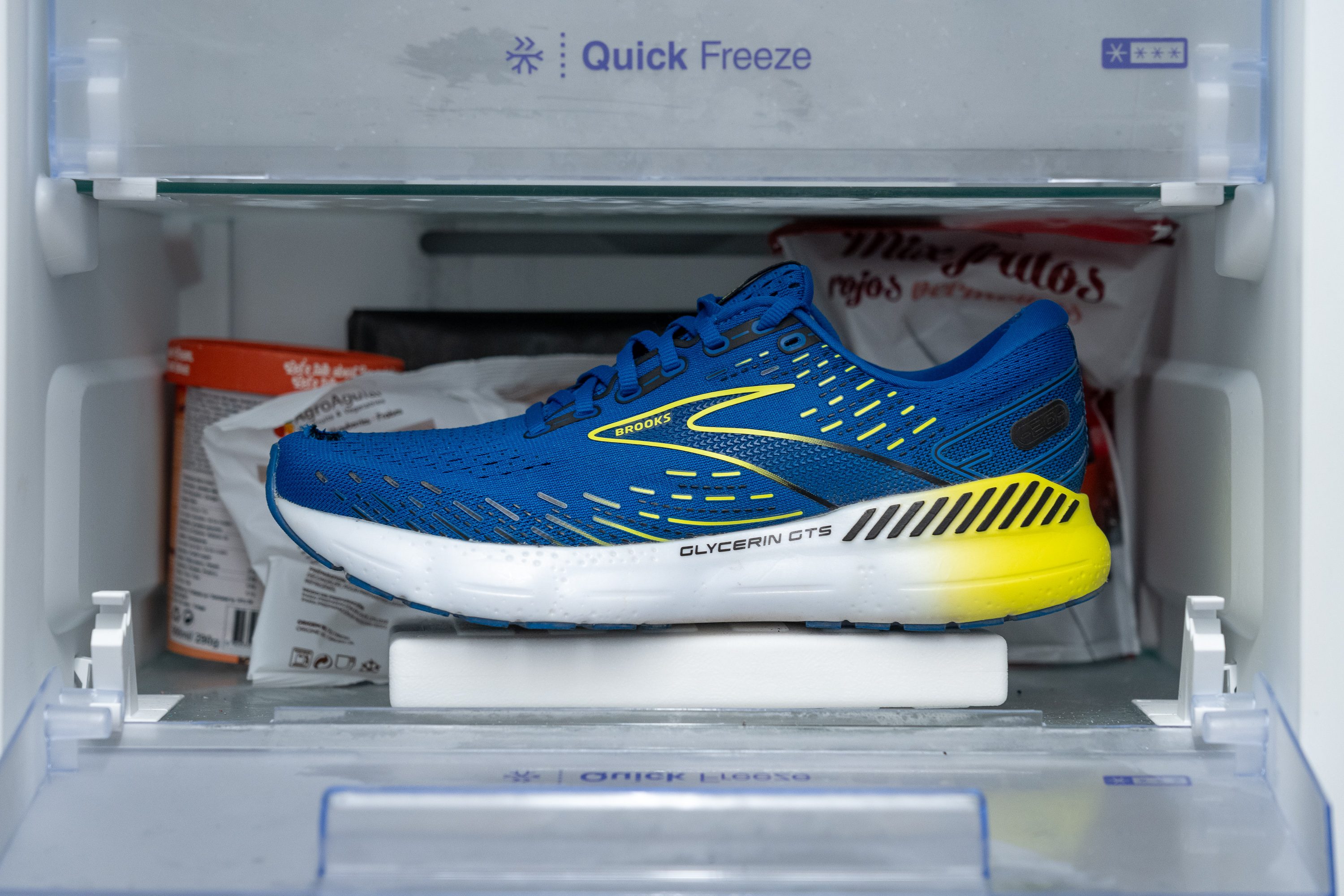
| Glycerin GTS 20 | 24% |
| Average | 24% |
Reflective elements
Finally, it's quite disappointing that a $160 shoe like this lacks reflective elements, a trend we're seeing in many brands.
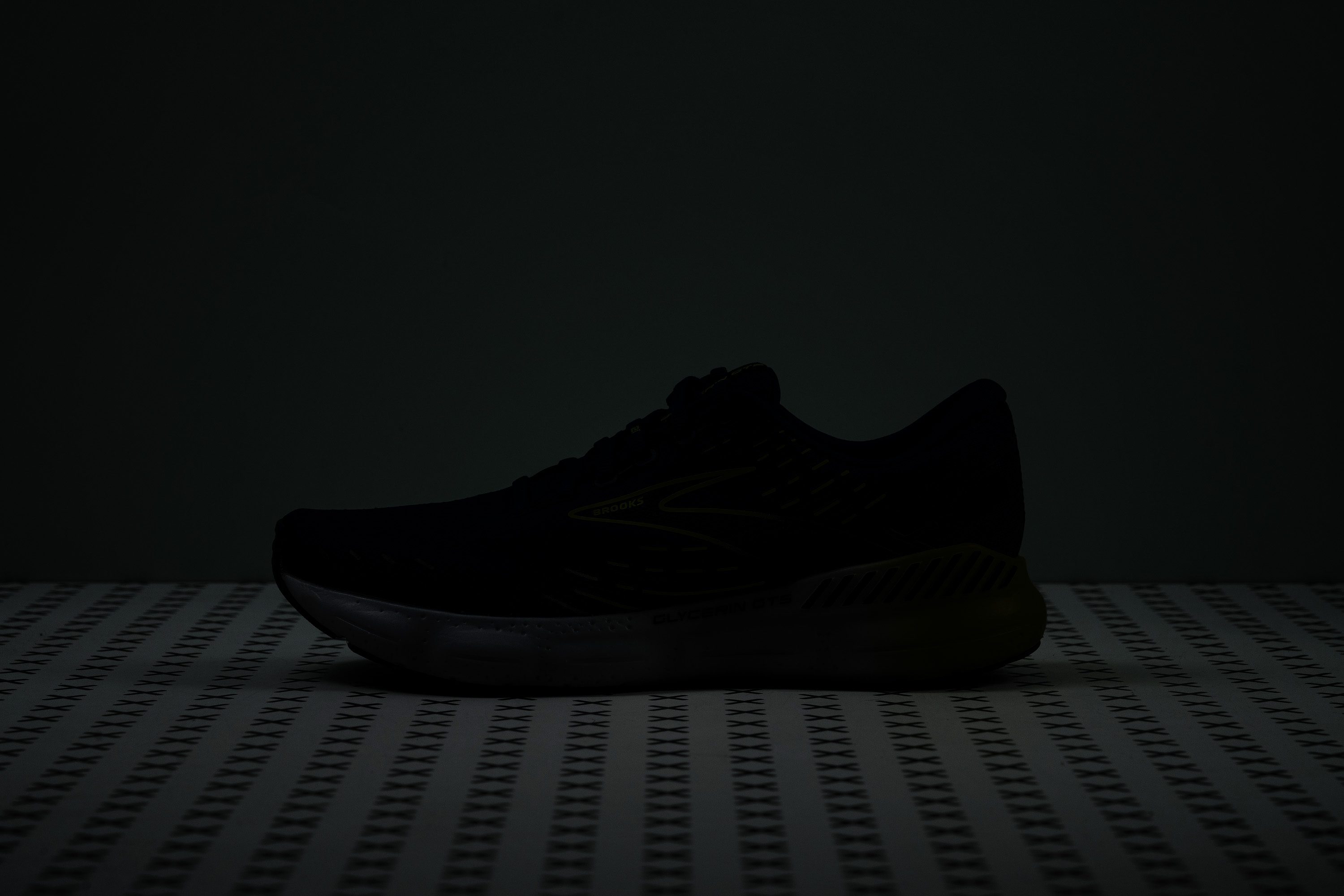
| Glycerin GTS 20 | No |
Tongue padding
Brooks designers likely decided a gusset wasn't necessary for the tongue because of its massive padding. With a thickness of 9.9 mm, it's like a pillow for your instep, enhancing a snug lockdown.

| Glycerin GTS 20 | 9.9 mm |
| Average | 5.8 mm |
Tongue: gusset type
The lack of a gusseted tongue in this shoe disappoints us, especially given its $160 price tag.
While this doesn't pose major problems, it could affect the perfect lockdown some of us might seek. For a more secure fit, we'd recommend considering the Hoka Arahi 6 as an alternative.
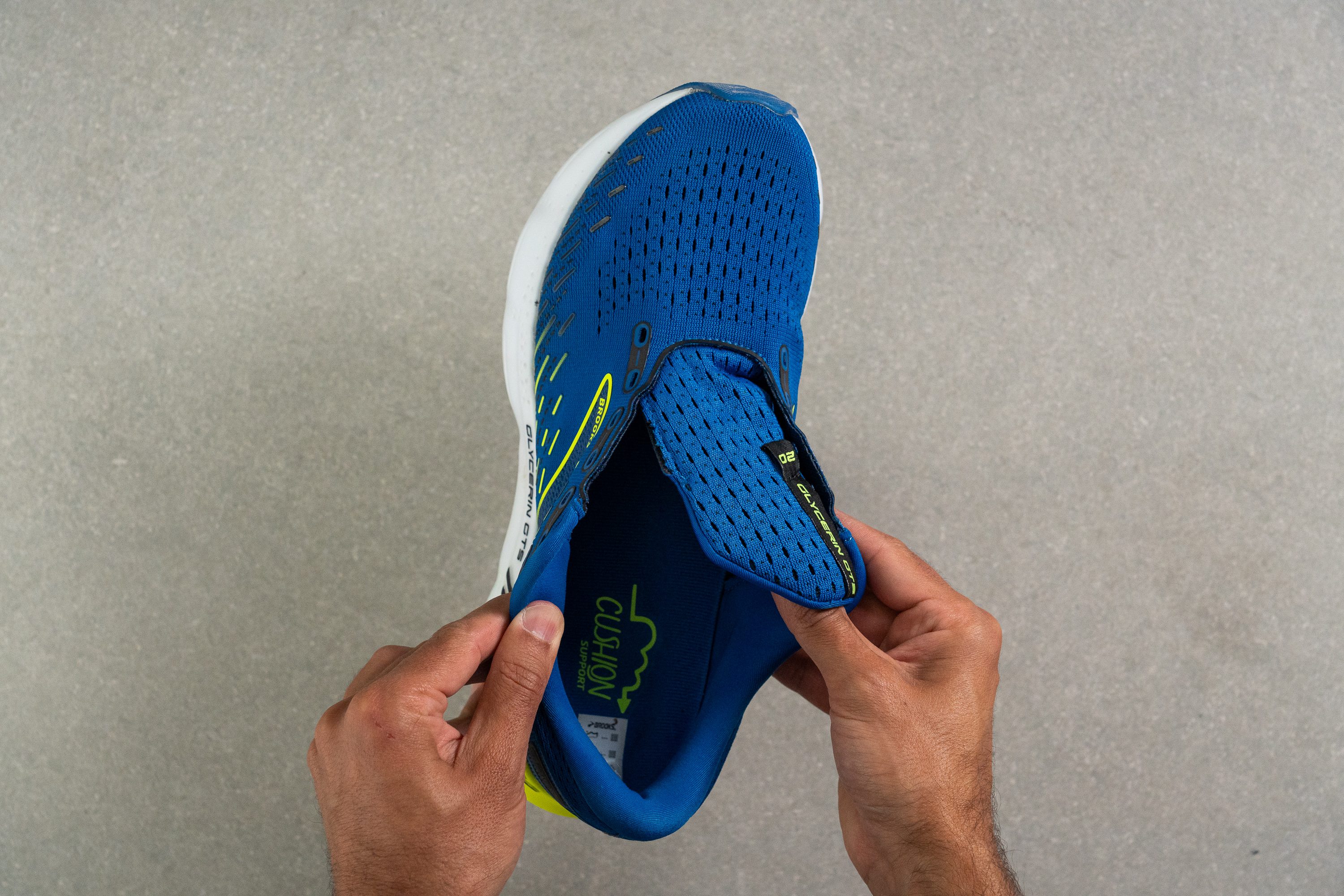
| Glycerin GTS 20 | None |

